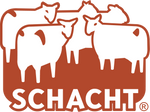By Kate White I keep having to remind myself that I’m a beginner. Working for Schacht, a company that produces spinning wheels and looms, I spend a fair amount of time thinking about the crafts. Shortly after starting here, I learned to spin and weave, but between the planning, replanning, obsessing, and fantasizing, I spend a relatively small amount of time actually making. After I made my challah cover, however, I had an unwarped Cricket Loom and lots of beautiful, leftover hand-dyed yarn. I also had a roommate who’d been tolerating a kitchen full of dye pots and had a birthday coming up.

A long, skinny scarf seemed just the ticket – with the tools and materials immediately at hand, and a deadline, this scarf would practically weave itself! I found that clearing the mental clutter and choosing a simple project helped me focus on developing two other important aspects of weaving: technique and instinct.
Warping
When I first set up my loom to warp, it was backwards! When direct-warping a rigid heddle loom, the reed should be in neutral, which is the groove near the back of the loom. The front of the loom faces your warping peg.
Make sure the apron bar goes over the back beam. It’s easy to just pick up the apron bar where it sits and start warping, but if it’s going under the beam, you won’t get a proper shed. We get calls every week from experienced weavers who have made this mistake – it’s easy to do! My first weaving teacher told me that the apron bars will give your loom a hug. A double-check before you start warping will save you a lot of grief.
Weaving
This scarf ended up being nearly 8 feet long, so I had a lot of practice with my selvedges. By not complicating my pattern, I had more awareness of getting the proper tug and angle in my picks. In each pick, I paid attention to how tight I was pulling along the selvedge thread, and to the angle at which I was placing the yarn in the shed.
I also focused a lot on my beat – as I mentioned in my previous post, I packed my challah cover at nearly twice the sett that was called for by the yarn. With this scarf, I was very careful to beat gently and maintain about 8 picks per inch. I counted at first, and then got a feeling for it and just checked occasionally. Different projects will have different needs, but reminding myself to be mindful of the process will help me in the execution of plan into product.
Color
I’ve been intimidated by color in my weaving, and have tended work more texture via pattern. Working with natural dyes, however, made me want to let the colors speak for themselves. I had plenty of yardage in two of my hand-dyed colorways, and pillaged my stash of commercial yarns for a third. I did a modified Fibonacci sequence (“modified” in that I messed up the order of some of the threads and decided not to fix it) for the warp. The colors were a seafloor blue (the commercial yarn) and the brown that was my weft for the challah cover.
For the weft, I used a hand-dyed skein that had a run of brown to pink. This yarn was my sample warp from my challah cover, wherein I displayed a total lack of understanding for how a warp works. The great news was that I had actually planned for the sample, so I got the education, a second chance at my goal warp, and a skein of yarn that was completely lovely. I was a little concerned about the pinkness of the yarn for my recipient, but with the other colors, it blended into a lovely field of russet tones.

My color changes were very subtle, so I didn't put any thought into transitioning between stick shuttles, but Denise wrote a blog on the treatment of color changes that you might find helpful for semi-solid yarns.
With a weekend, a good tv show, and my roommate out of town, I warped and wove this scarf in just a few hours. It was a great reminder that simplicity lends itself to success. I am still a beginning weaver after all, and there was plenty of opportunity to challenge myself. Plus, by not being overwhelmed with over-complex visions, I actually wound up with a finished project in hand, in time for my friend's birthday. That's pretty rewarding.

